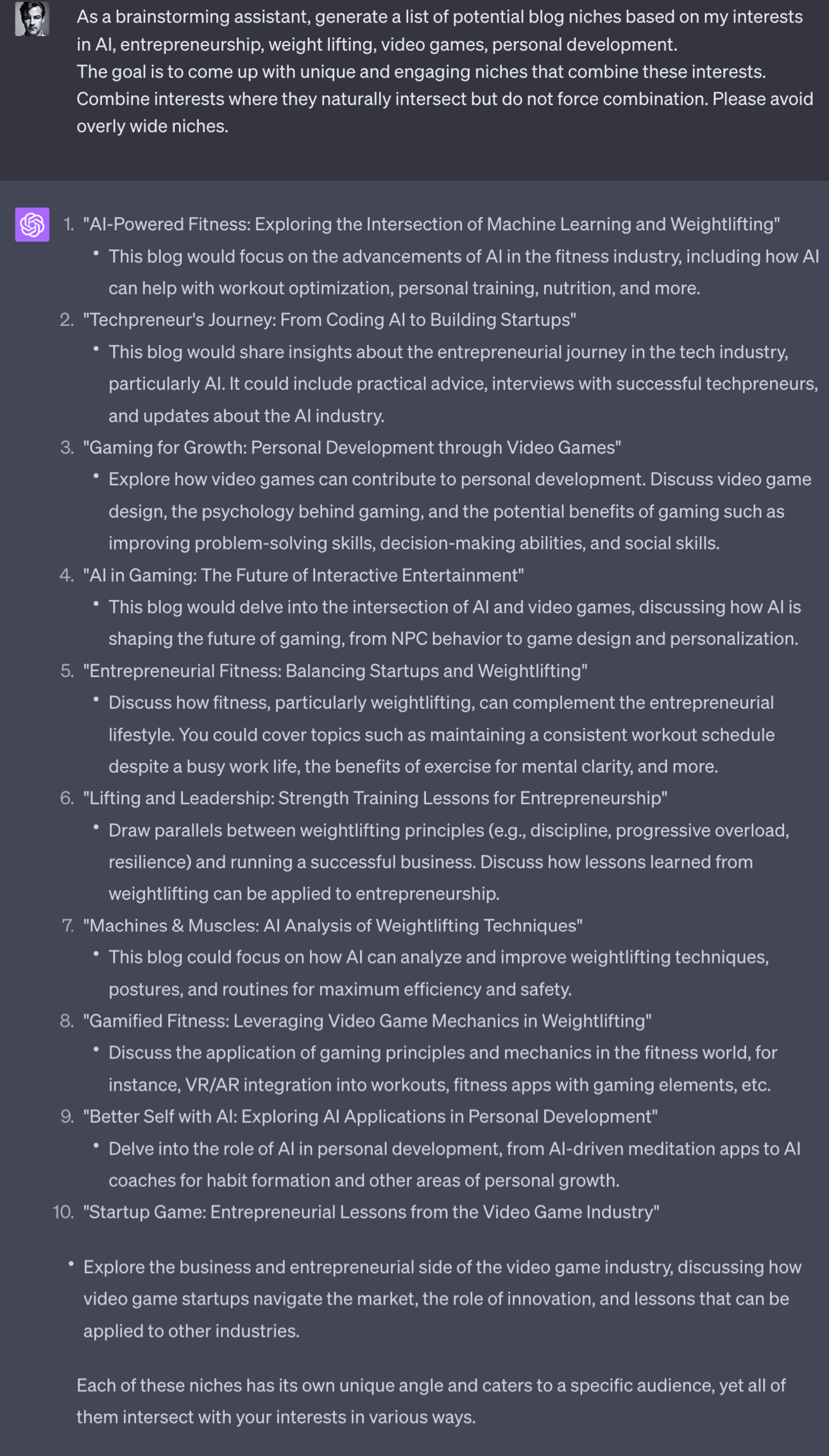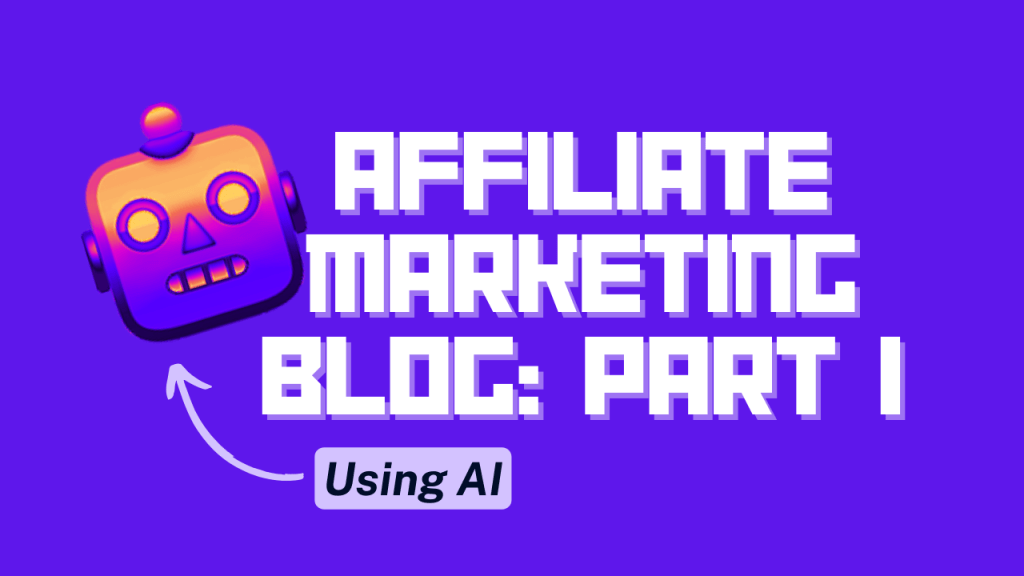Hey Prompt Entrepreneur,
We asked you last week if you wanted an in-depth guide on how to start a business using ChatGPT and you answered with a resounding YES!
We followed that up with another poll (yay democracy!) on which business you wanted us to cover. The results said:

Blogging & Affiliate marketing using ChatGPT! Nice!
This is one that’s near and dear to my heart.
My first big blog was https://learnchinesecharacters.academy/, a blog site to help people learn Chinese characters. In fact this was my FIRST online business.
Therefore helping others get started in this space is really exciting
What is blogging and affiliate marketing?
In short this business revolves around:
- Setting up a blog that attracts traffic
- Adding “affiliate” links to your content that, when clicked and lead to a purchase, pay you a % of the purchase.
For example if I add an Amazon link to some £120 Birkenstock sandals into one of my blog articles and someone clicks the link, goes to Amazon and purchases I will get 10% or £12 from Amazon.
If I can send 100 people to purchase via that link I will generate £1200.
The key with affiliate marketing is volume, which comes from ranking well on Google which, in turn, depends on having lots of good content on my blog.
Blog articles are the engine that drives affiliate marketing: news, reviews, features, comparisons, in depth breakdowns of products in my affiliate category.
Why should I care?
Blogging and affiliate marketing is BIG business
According to Statista, affiliate marketing spending in the U.S alone was set to hit $8.2 billion by 2022. Furthermore, a report by Hosting Tribunal reveals that bloggers who earn over $50,000 per year spend an average of 3-10 hours writing a blog post, while 63.2% of those earning over $2000/month invest less than 3 hours.
You’re probably thinking: “That sounds amazing, but how do I keep up with the constant demand for fresh content?” A blog needs to be fed with LOTS of new, fresh, quality content for Google to take notice.
Enter ChatGPT.
With ChatGPT, you can create quality content faster and more efficiently, allowing you to stay ahead of the curve, and offering you a competitive edge in today’s fast-paced digital environment.
ChatGPT means that affiliate marketing is at an inflection point where business owners who use AI can outstrip business owners who do not.
And I’m not just talking about blog writing – ChatGPT can be used at all points in the set up and operation of an affiliate marketing focused blog.
And that’s just what we’re going to show you this week!
Structure of the week
It’s going to be a busy week. But by the end you’ll have the structure, system and prompts to launch your own affiliate blog. In brief here’s the week:
- Market Research and Niche Selection: This stage involves identifying your interests and passions, conducting keyword research to understand what potential readers are searching for, analysing your competition to identify their strengths and weaknesses, and validating your chosen niche to ensure there’s a viable market and potential for monetization.
- Blog Setup and Design: This stage involves choosing a blogging platform, selecting a domain name that’s relevant and easy to remember and designing a brand.
- Content Creation with ChatGPT: This stage involves developing a content strategy and calendar, using ChatGPT to generate content such as blog posts, outlines, and new content ideas, editing and optimizing the content for accuracy, style, voice, and SEO, and including affiliate links in a natural, non-spammy way.
- Promotion, SEO, and Link Building with ChatGPT: This stage involves using ChatGPT to generate SEO-friendly meta descriptions, title tags, and alt text for images, promoting your blog posts on social media, building an email list and sending regular newsletters, reaching out to other bloggers for guest posting opportunities and link building, and monitoring and adjusting your strategy based on your blog’s performance data.
And here’s a challenge. I’ve intentionally split this guide up over four emails so you have a handful of actions to do daily. Instead of being overwhelmed. So if you are up for up, follow along.
Connect with me on Twitter and let me know how it’s going.
Let’s get started:
Market Research and Niche Selection
1. Identify Your Interests and Passions
The first step is to identify what you’re passionate about. This could be anything from cooking to technology to fitness.
Here is an initial ChatGPT prompt to start brainstorming topics:
As a brainstorming assistant, generate a list of potential blog niches based on my interests in [insert interests here].
The goal is to come up with unique and engaging niches that combine these interests. Combine interests where they naturally intersect but do not force combination. Please avoid overly wide niches. Plug in interests, your work area, skills, hobbies. Anything that is important to you.
It’s important that we start from a basis of what you actually want to write about if we want to create a unique and genuinely interesting blog.
Yes, we’ll be using AI to help with writing later but we need the personal touch from working with a topic we want to write about and have the authority to write about.
Prompt Output 💬

2. Conduct Keyword Research
Once you’ve identified your niche, it’s time to conduct keyword research. This will help you understand what potential readers in your niche are searching for.
Keywords are basically how people use Google – their search terms.
You can use tools like Google Keyword Planner, SEMrush, or Ahrefs, or you can ask ChatGPT to get started.
As a SEO assistant, suggest a list of potential keywords for a blog focused on [topic]. The task involves identifying high-volume, low-competition keywords.
The goal is to find keywords that can drive organic traffic to the blog. Please avoid extremely competitive keywords.For topic take the topic you’ve decided upon from the first step. Or plug in the whole answer that ChatGPT gave you (with title, description etc.) to get even more detail.
Prompt Output 💬

Pro Prompts ⭐️
- For better results use the ChatGPT plugin SERPstat SEO tool to use live data. Requires paid ChatGPT plan
- Alternatively take your keywords to Google Ads Keyword planner to get precise keyword volume and competition. Free tool.
- Also plug your topic into Answer the Public to start to widen your keywords and see the sort of blog topics you could be writing.
3. Analyze Your Competition
Understanding your competition is crucial. Look at the top blogs in your chosen niche. What are they doing well? What can you do better or differently?
ChatGPT can help with this:
As a competitive analysis assistant, provide an analysis of the top three blogs in the [topic] niche. The task involves identifying their strengths, weaknesses, and unique selling points.
The goal is to understand what they're doing well and where there are opportunities for differentiation.
Please avoid personal opinions and stick to objective analysis. Present results in a table.Prompt Output 💬
Using [entrepreneurship and fitness] as the niche:

4. Validate Your Niche
Finally, you need to validate your chosen niche. Is there an audience for your topic? Are there affiliate programs available?
ChatGPT can assist with this validation:
As a market research assistant, validate the potential of the entrepreneurship and fitness niche. The task involves identifying the size of the audience, potential for monetisation, and availability of affiliate programs.
The goal is to ensure there's a viable market for this blog. Please avoid assumptions and use data-driven insights.Prompt Output 💬

Pulling it together
These four prompts will get your started with defining what exactly your blog is going to be about.
We started with your skills and interests, combined this with keyword research to convert into “Google speak” then checked competition and business viability.
If the results from ChatGPT aren’t encouraging (especially in prompt 4!) go back and tweak your variables until you land on something more promising.
It’s super important to have a strong, exciting idea that also has a market for you build a business. Getting this stage right will make the rest of the process much easier!
And remember, over the next few days we’re going to cover the three remaining steps:
- Blog Setup and Design: This stage involves choosing a blogging platform, selecting a domain name that’s relevant and easy to remember and designing a brand.
- Content Creation with ChatGPT: This stage involves developing a content strategy and calendar, using ChatGPT to generate content such as blog posts, outlines, and new content ideas, editing and optimizing the content for accuracy, style, voice, and SEO, and including affiliate links in a natural, non-spammy way.
- Promotion, SEO, and Link Building with ChatGPT: This stage involves using ChatGPT to generate SEO-friendly meta descriptions, title tags, and alt text for images, promoting your blog posts on social media, building an email list and sending regular newsletters, reaching out to other bloggers for guest posting opportunities and link building, and monitoring and adjusting your strategy based on your blog’s performance data.
